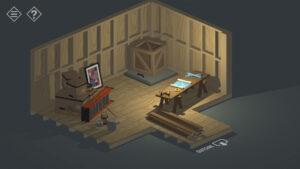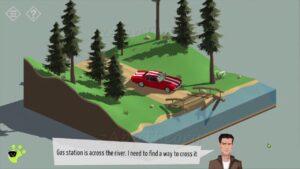The game I choose for this critical play is the Tiny Room Stories Town Mystery, an interesting puzzle game that utilizes 3D axes to navigate around each scene and thus progress further into the main story. Unlike any other puzzle game, the mechanics of this game offer a hyper realistic experience when it comes to finding truly scattered clues to solve the story’s mystery, and does so in a way that is lighthearted, satisfying, organized and not in an overwhelming way.
Mechanically, Tiny Room is quite similar to the Almost Gone, where 3D axes and views are used, showcasing the room of investigation over a simple, one color background. Players can zoom in and out of single rooms in a larger building, rotate the buildings around to gain access to different aspects of the room, and zoom in on specific mini puzzles when they click on objects of intrigue in the grander image.
Let’s talk, first, about the mechanics of rotation. This mechanic adds in an interesting intractability because the space is not flat; the clues and strangeness of the scene are not all laid out in a 2D image where you could eventually see everything interesting without much difficulty or interference. Instead, some clues just cannot be seen because the player is logically not at the right perspective to see it. Thus, if they simply stopped here, they would not make progress in the story. The player has to think: if this clue is leading them to this space in the game, how come they don’t see anything right away? How might they navigate, in other words, rotate the space, so that something of interest can be seen to explore? Do they need an aerial view to see the pattern? Maybe they can manipulate a side view, a 2D view to best see the pattern? This adds a layer of simple complexity to not only the puzzle but also finding the path to each puzzle that makes the game experience realistic. How many times have you looked for something and everything is just laid out for you, the shelves and the island table in the same plane as one another? This mechanic of rotating a 3D scene to access different perspectives replicates how real life searching is and thus makes the experience of the game less hollow and more satisfying. Compared to other mobile detective games, this mechanic asks the player to simply do more. In this way, the game becomes more fun as if it feels that there is more to accomplish and to explore

The 3D-ness also adds yet another layer of exploration, this time with the mechanics of zooming in and out. This is not to gain a closer, non-interactive look at an object of space; it provides more. This adds the opportunity for another layer of puzzles under the other main puzzle. Usually each chapter asks the player to explore a whole building; chapter 2 explores an entire 3 floor office building with an average of about 5 rooms on each floor. There’s a puzzle to get in the building and then to get into each floor, and then you can zoom into each room to solve those floor-related puzzles, or just move things around to find clues. Then you can zoom in further to solve the puzzles tied to certain objects in the room. All these clues work together to piece together the bigger mystery of the building. This mechanic creates more for the player to do, making the experience not only realistic to real-world searching, but just more fun because it feels like there is a hierarchy to the puzzles. It’s a satisfying game experience to be led deeper and deeper into something and then to emerge and use that to solve the bigger mystery. Again, there’s a bigger range for accomplishment here that makes the experience addicting. And frustration, at least with the way the game is structured, is kept at by the way the game compartmentalizes itself; it is very organized. Even if puzzles overall intertwine together, they are all organized by each room and it’s very easy to get back to those puzzles.
As for some critique, I remember playing a level that was not in a building, but rather an open space in the forest (Act 2). Rooms are unique in what they hold and look like, and applying this 3D-ness to that makes the experience feel layered, complex yet organized. Applying this 3D-ness to a vast space that all looks similar to each other caused a lot of confusion for me. There didn’t seem a reason, and because everything looked the same, it was easy to forget how each perspective was unique to the other. The puzzles felt less interesting to me because it was just harder to find them and remember where they were. Maybe this was the difficulty the devs were aiming for, but in terms of game experience, it was tedious and frustrating. And the variety of puzzles were limited because some puzzles wouldn’t have made sense with the space. This tells me that, at least for a game like Tiny Room, the best space to use for puzzles are buildings and places where having a lot of rooms makes sense. That way, the variety, complexity and absurdity of the puzzles aren’t limited, and as a developer and player, would be more fun to interact with and implement.

Again, the 3D layout of Tiny Room offers the game many mechanics that are unique to that game. Overall, this style helps puzzle games become more involved and realistic. It makes the player’s experience more satisfyingly complex and thus more fun.



